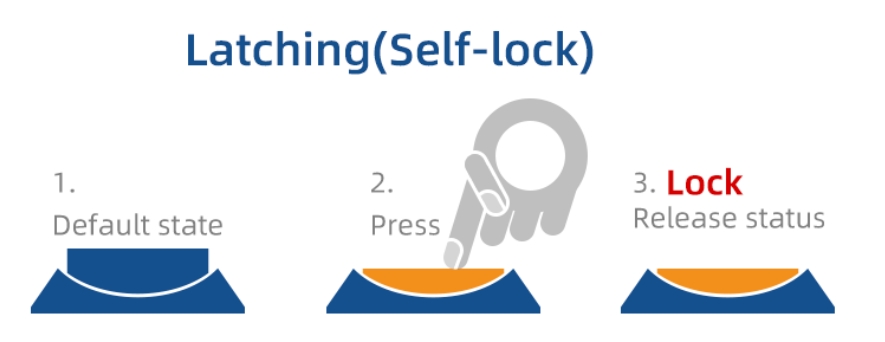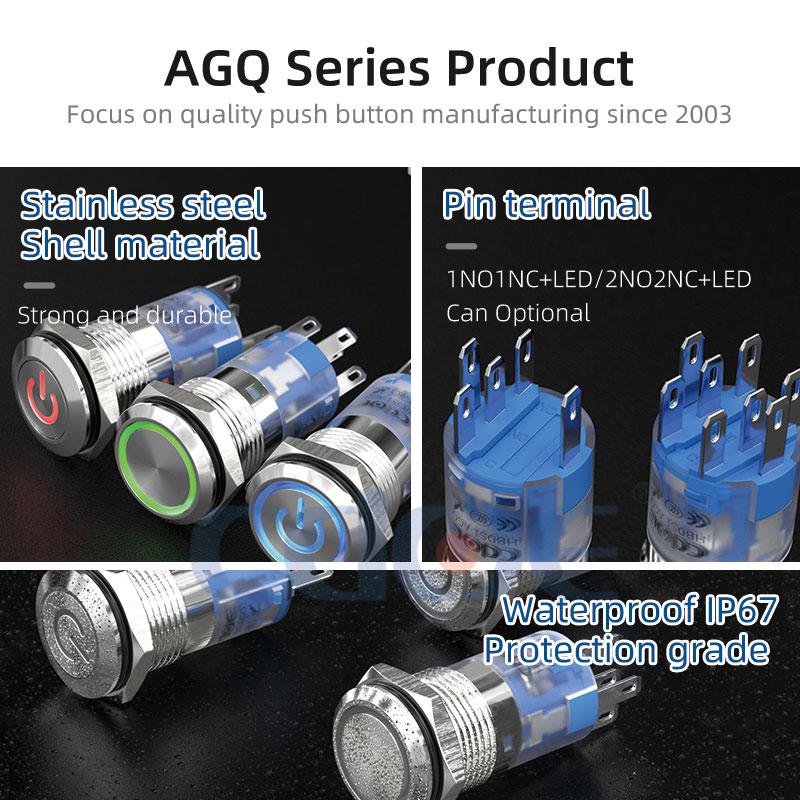★ News Navigation Panel
What is a latching push button switch?
A latching push button switch is a type of electrical switch that changes the state of the circuit when pressed and retains that state until it is pressed again. Unlike momentary switches, which change the circuit state only when held down, a latching switch “locks” the circuit in its new state. This feature makes them ideal for use in devices where the device needs to remain on or off without continuous button pressing.
The basic working principle of a latching push button switch lies in its locking mechanism. When the button is pressed, a mechanical latch is triggered, holding the circuit in an open or closed state. The switch remains in this state until the next press, which releases the latch and returns the switch to its original position. This “toggle” action distinguishes a latching switch from momentary switches, where the button must be held to maintain the circuit state.
For example, when using a typical latching switch, pressing the button once will close the circuit and turn on the connected device. Pressing it again will open the circuit, turning off the device. This eliminates the need for continuous button pressing, which is especially convenient in applications such as lighting, where simple toggling is sufficient.
Learn more about latching buttons

What are the features of a self-locking button?
Self-locking buttons, also known as latching buttons, have several important characteristics that make them suitable for industrial, commercial, and household applications:
1. Mechanical locking mechanism: The mechanical latch is a key feature of a latching button. This design allows the button to maintain its state without requiring constant pressure from the user.
2. State memory function: Even in the event of power loss, the latching button retains its last state. This feature is especially important in applications where the equipment needs to resume operation in its previous state after power is restored, without manual intervention.
3. Durability and long lifespan: Latching buttons are made from high-quality materials, ensuring reliability and longevity. They are designed for use in high-frequency conditions and can withstand harsh external impacts, making them suitable for industries with intensive equipment usage.
4. Custom design and aesthetic options: Latching buttons can be customized with LED lighting, various shapes, colors, and materials to match the overall product design. This flexibility makes them ideal for applications where both form and function are important, such as household appliances or consumer gadgets.
Why choose our products?
When choosing a latching button, it’s essential to consider not only the mechanical design but also the materials and protection level. Our latching buttons offer the following advantages:
1. High-quality mechanical design: Our switches feature an advanced mechanical latching mechanism that ensures reliable performance even in extreme conditions. The internal mechanism is resistant to wear, guaranteeing the switch’s operability for extended periods of use.
2. Premium materials: We use only high-quality materials in the manufacturing of our buttons. This includes corrosion-resistant metals and waterproof casings, which protect the internal components from dust, moisture, and other environmental factors.
3. Wide range of applications: Our latching buttons are suitable for various industrial and commercial applications, from heavy machinery to consumer electronics. Thanks to flexible design solutions, we can adapt our products to meet the specific needs of your project, ensuring both functionality and aesthetic appeal.
Applications of latching push buttons
Latching push button switches are widely used in various industries due to their ability to maintain the circuit’s state without constant user intervention. Here are a few examples of their applications:
1. Industrial automation: In industrial automation, latching buttons are often used to control the start and stop of large equipment. The ability to keep a machine running without constant monitoring is crucial for improving efficiency and ensuring safety.
2. Safety systems: Latching buttons play a key role in safety systems, especially as emergency stop buttons (E-stop). These buttons are designed to immediately cut power to equipment or systems in critical situations.
3. Consumer electronics: In household devices, such as lamps, fans, or power tools, latching buttons are often used for on/off functionalities. These switches are convenient to use and allow easy control of devices with a single press.
4. Aerospace and automotive industries: In the aerospace and automotive sectors, latching buttons are often used to control critical systems, such as engine start/stop mechanisms or lighting controls. These buttons must meet strict safety and reliability standards to ensure operation in extreme conditions.
5. Medical equipment: In medical devices, reliability is paramount. Latching buttons are used in various devices, including surgical equipment and patient monitoring systems. The ability to maintain the device’s state without constant intervention helps ensure stable operation during medical procedures.
Find out how we can customize our product for your industry
How to maintain a latching push button?
To ensure the long-term reliability and performance of a latching button, regular maintenance is recommended. Here are some key tips for taking care of these switches:
1. Regular cleaning: In environments exposed to dust, moisture, or other contaminants, it’s important to clean the latching button regularly. Use a dry cloth or compressed air to remove dust or debris from the button’s surface to prevent contaminants from entering the internal mechanism.
2. Inspect mechanical parts: Since the button relies on a latching mechanism, it’s important to regularly check how the button presses. If the button sticks, doesn’t respond, or is hard to press, lubrication of moving parts or replacement of old components may be required.
3. Check electrical connections: Loose or corroded electrical connections can cause malfunctions or performance issues. Regularly inspect the wiring terminals to ensure all connections are secure and free of corrosion.
Frequently Asked Questions (FAQs)
Question 1: Can a latching button be used outdoors?
Yes, many latching buttons are designed with waterproof casings and can meet protection standards such as IP65 or higher, making them suitable for outdoor use. Be sure to choose a model that meets the environmental requirements of your application.
Question 2: How do I choose the right latching button for my project?
When choosing a latching button, consider the following factors:
- Technical specifications: Ensure the button meets the requirements for voltage, current, and environmental protection.
- Materials: Choose buttons made of durable and corrosion-resistant materials, especially for environments exposed to moisture or dust.
- Functionality: Decide whether you need features like lighting, color indication, or other additional functions.
- Aesthetics: For consumer devices, the appearance of the button is important to match the product design.
Question 3: How long do latching buttons last?
The lifespan of a latching button depends on the quality of the materials, the frequency of use, and the operating conditions. High-quality buttons, such as ours, are designed for tens of thousands of on/off cycles and can last for many years even in challenging conditions.
Question 4: Can a latching button be repaired?
Yes, in most cases, latching buttons can be repaired. Regular maintenance, such as cleaning, lubricating mechanical parts, and checking electrical connections, can significantly extend the button’s lifespan. If the button stops working, contact the manufacturer or a specialist for repair or replacement.
Question 5: What safety standards should latching buttons comply with?
Latching buttons, especially those used in industrial applications, should comply with standards such as IP rating (e.g., IP65 for dust and water protection) as well as IEC or UL standards. Make sure the button you choose has the appropriate certification for your application.

